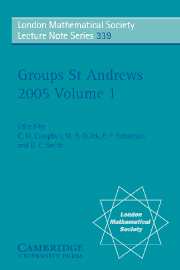Book contents
- Frontmatter
- Contents
- Introduction
- Aspects of infinite permutation groups
- Self-similarity and branching in group theory
- On surface groups: motivating examples in combinatorial group theory
- Nilpotent p-algebras and factorized p-groups
- Classification of finite groups by the number of element centralizers
- Algorithmic use of the Mal'cev correspondence
- Minimal but inefficient presentations for semi-direct products of finite cyclic monoids
- The modular isomorphism problem for finite p-groups with a cyclic subgroup of index p2
- On one-generated formations
- New results on products of finite groups
- Radical locally finite T-groups
- Explicit tilting complexes for the Broué conjecture on 3-blocks
- Conjugacy classes of p-regular elements in p-solvable groups
- An algorithm for the unit group of the Burnside ring of a finite group
- Integral group ring of the first Mathieu simple group
- Embedding properties in direct products
- Malcev presentations for subsemigroups of groups — a survey
- Finite groups with extremal conditions on sizes of conjugacy classes and on degrees of irreducible characters
- Conjugacy class structure in simple algebraic groups
- On automorphisms of products of groups
- Linear groups with infinite central dimension
- G-automata, counter languages and the Chomsky hierarchy
- An embedding theorem for groups universally equivalent to free nilpotent groups
- Irreducible word problems in groups
- Recent growth results
Conjugacy classes of p-regular elements in p-solvable groups
Published online by Cambridge University Press: 07 May 2010
- Frontmatter
- Contents
- Introduction
- Aspects of infinite permutation groups
- Self-similarity and branching in group theory
- On surface groups: motivating examples in combinatorial group theory
- Nilpotent p-algebras and factorized p-groups
- Classification of finite groups by the number of element centralizers
- Algorithmic use of the Mal'cev correspondence
- Minimal but inefficient presentations for semi-direct products of finite cyclic monoids
- The modular isomorphism problem for finite p-groups with a cyclic subgroup of index p2
- On one-generated formations
- New results on products of finite groups
- Radical locally finite T-groups
- Explicit tilting complexes for the Broué conjecture on 3-blocks
- Conjugacy classes of p-regular elements in p-solvable groups
- An algorithm for the unit group of the Burnside ring of a finite group
- Integral group ring of the first Mathieu simple group
- Embedding properties in direct products
- Malcev presentations for subsemigroups of groups — a survey
- Finite groups with extremal conditions on sizes of conjugacy classes and on degrees of irreducible characters
- Conjugacy class structure in simple algebraic groups
- On automorphisms of products of groups
- Linear groups with infinite central dimension
- G-automata, counter languages and the Chomsky hierarchy
- An embedding theorem for groups universally equivalent to free nilpotent groups
- Irreducible word problems in groups
- Recent growth results
Summary
We shall assume that any group is finite. One of the classic problems in Group Theory is to study how the structure of a group G determines properties on its conjugacy class sizes and reciprocally how these class sizes influence the structure of G. During the nineties several authors studied this relation by defining and studying two graphs associated to the conjugacy class sizes. In 1990 (see [8]), E. Bertram, M. Herzog and A. Mann defined a graph Γ (G) as follows: the vertices of Γ (G) are represented by the non-central conjugacy classes of G and two vertices C and D are connected by an edge if |C| and |D| have a common prime divisor. Later, this graph was studied in [12] and also used in [9] to obtain properties on the structure of G when some arithmetical conditions are imposed on the conjugacy class sizes. On the other hand, in 1995, S. Dolfi [14] studied a dual graph, Γ*(G), defined in the following way: the set of vertices are the primes dividing some conjugacy class size of G and two primes r and s are joined by an edge if rs divides some conjugacy class size of G. Independently, G. Alfandary also obtained some properties of these graphs (see [1]).
We shall suppose that G is a p-solvable group for some prime p. We shall consider the set of p-regular classes in G, that is, the conjugacy classes of p′-elements in G.
- Type
- Chapter
- Information
- Groups St Andrews 2005 , pp. 224 - 229Publisher: Cambridge University PressPrint publication year: 2007
- 1
- Cited by



